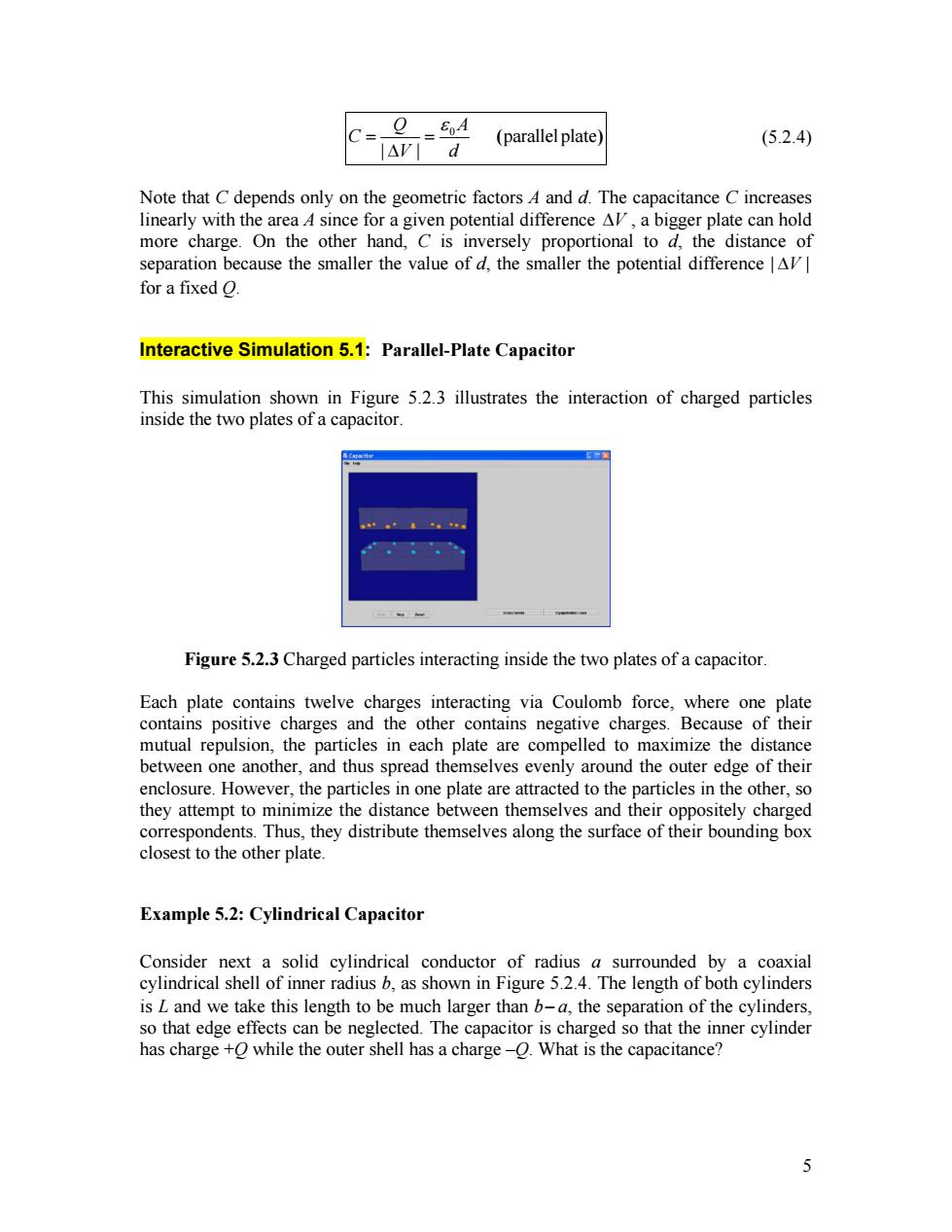正在加载图片...

Q 60A (parallel plate) (5.2.4) |△d Note that C depends only on the geometric factors 4 and d.The capacitance C increases linearly with the area A since for a given potential difference Al,a bigger plate can hold more charge.On the other hand,C is inversely proportional to d,the distance of separation because the smaller the value of d,the smaller the potential difference AV for a fixed O. Interactive Simulation 5.1:Parallel-Plate Capacitor This simulation shown in Figure 5.2.3 illustrates the interaction of charged particles inside the two plates of a capacitor. 。9,生4。 Figure 5.2.3 Charged particles interacting inside the two plates of a capacitor. Each plate contains twelve charges interacting via Coulomb force,where one plate contains positive charges and the other contains negative charges.Because of their mutual repulsion,the particles in each plate are compelled to maximize the distance between one another,and thus spread themselves evenly around the outer edge of their enclosure.However,the particles in one plate are attracted to the particles in the other,so they attempt to minimize the distance between themselves and their oppositely charged correspondents.Thus,they distribute themselves along the surface of their bounding box closest to the other plate. Example 5.2:Cylindrical Capacitor Consider next a solid cylindrical conductor of radius a surrounded by a coaxial cylindrical shell of inner radius b,as shown in Figure 5.2.4.The length of both cylinders is L and we take this length to be much larger than b-a,the separation of the cylinders, so that edge effects can be neglected.The capacitor is charged so that the inner cylinder has charge +O while the outer shell has a charge-O.What is the capacitance? 50 parallel plate Q A C | V | d ε = = ∆ ( ) (5.2.4) Note that C depends only on the geometric factors A and d. The capacitance C increases linearly with the area A since for a given potential difference ∆V , a bigger plate can hold more charge. On the other hand, C is inversely proportional to d, the distance of separation because the smaller the value of d, the smaller the potential difference | | ∆V for a fixed Q. Interactive Simulation 5.1: Parallel-Plate Capacitor This simulation shown in Figure 5.2.3 illustrates the interaction of charged particles inside the two plates of a capacitor. Figure 5.2.3 Charged particles interacting inside the two plates of a capacitor. Each plate contains twelve charges interacting via Coulomb force, where one plate contains positive charges and the other contains negative charges. Because of their mutual repulsion, the particles in each plate are compelled to maximize the distance between one another, and thus spread themselves evenly around the outer edge of their enclosure. However, the particles in one plate are attracted to the particles in the other, so they attempt to minimize the distance between themselves and their oppositely charged correspondents. Thus, they distribute themselves along the surface of their bounding box closest to the other plate. Example 5.2: Cylindrical Capacitor Consider next a solid cylindrical conductor of radius a surrounded by a coaxial cylindrical shell of inner radius b, as shown in Figure 5.2.4. The length of both cylinders is L and we take this length to be much larger than b− a, the separation of the cylinders, so that edge effects can be neglected. The capacitor is charged so that the inner cylinder has charge +Q while the outer shell has a charge –Q. What is the capacitance? 5